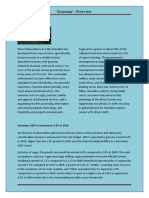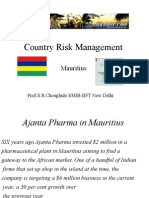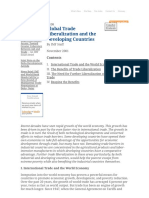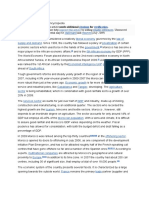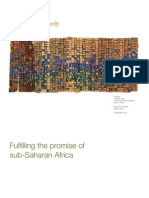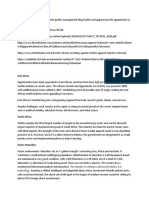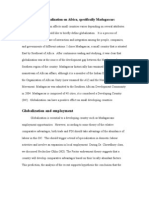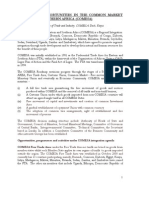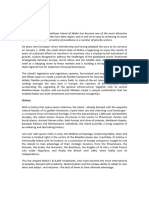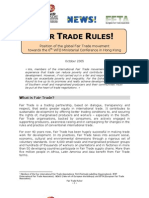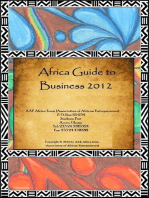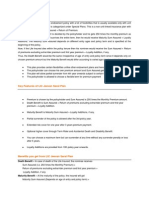Presentation Report
Presentation Report
Uploaded by
John ArjunCopyright:
Available Formats
Presentation Report
Presentation Report
Uploaded by
John ArjunCopyright
Available Formats
Share this document
Did you find this document useful?
Is this content inappropriate?
Copyright:
Available Formats
Presentation Report
Presentation Report
Uploaded by
John ArjunCopyright:
Available Formats
Mauritian Economy - A glimpse
Introduction The Mauritian economy has constantly shown remarkable resilience against global challenges happening since its independence in 1968. Indeed, recently crowned as one of the African lions which are driving the African economy, the island is often referred as a role model to other African nations. As Ruth Kagia, Country Director of World Bank for Mauritius pointed out: Mauritius is among the nine African countries with the highest GDP per capita, the island has without doubt a lot of lessons to give to other countries... it can serve as example for which the World Bank has always supported in its socio-economic development. In addition, for two consecutive years (2008 and 2009), the island earned the title of best place to do business in Africa. The seed of success of Mauritius was sown after the independence. The island developed from a low income, agriculturally based economy to a middle income diversified economy with manufacturing, tourist and financial service industries. The trajectory is also moving towards neo sectors such as seafood hub, health care, biomedical, knowledge among others:
Source: JEC presentation at Seafood Conference 03rd March 2006
CAULLYCHURN NITISH
Page 1
Mauritian Economy - A glimpse
Economic history Mauritius was not so successful when considering the pre-independence conditions. In fact, in the early sixties, the island was regarded as a terrifying case for Malthusian theory by a Nobel Prize Laureates for Economics: J.E Meade; he found little scope for economic progress and improvement in the standard of living of the population. At the time of its independence, the island was characterised by high unemployment during the 1970s and an overdependence on sugar. This overdependence started when being a sugarcane producer, the island joined the Sugar Protocol of the Lome Convention in 1975. The Protocol suggested that the sugar industry had a quota and a guaranteed price that enabled Mauritius to exploit the European market. Very quickly, Mauritius became the worlds tenth largest sugar exporter by fully utilising the Protocol advantage. In reality, the European Community purchased around 70% of the sugar produced at much higher prices (sometimes five times higher) than that of the world market.
CAULLYCHURN NITISH
Page 2
Mauritian Economy - A glimpse
Mauritius was basically a mono-crop economy with a small domestic market and a population of 700,000 inhabitants. It was clear that the import substitution strategy adopted at that time by the policy makers should be replaced by a more viable one. Consequently, an export-led strategy was identified and in 1970, the country established the Export Processing Zone (EPZ) which was founded on the experience of other small like-minded island with few natural resources (Singapore, Hong Kong, Taiwan). The EPZ provided the following: Duty free entry of capital goods and raw materials Tax holidays on corporate profits and dividends Free repatriation of capital and dividends Infrastructure and credits Relief from income taxes for the first ten years with further concessions on profits when reinvested in the island The export-led strategy resulted in a robust functioning of the manufacturing sector which benefitted from huge foreign investment, the economy growing at 6% annually and the unemployment rate fell from 20% to less than 2% between 1983 and 1993. In addition, in 1999, the EPZ exports accounted for 70% of the total exports. Moreover, the signature of the Multi Fibre agreement in 1982 marks another milestone for the economy of Mauritius. The agreement being a set of formal quota agreements governing the textiles and clothing trade provided yet another opportunity for the manufacturing sector to flourish. It is in these periods that many Hong Kong investors came to set up their firms in the island. Soon, local Mauritian companies began producing and exporting high quality knitwear to the west. Strikingly, Mauritius became a major exporter of textiles and garments and the third largest exporter of knitwear in the world. The largest manufacturer was Floreal group, a Mauritian company producing 4.3 million sweaters a year. In 1992, taking advantage of its strategic location (important maritime routes between Africa, Asia and Europe), Mauritius set up a free trade zone or Freeport to develop as a regional trade centre. The Freeport was established as a
CAULLYCHURN NITISH
Page 3
Mauritian Economy - A glimpse
duty free zone at port and airport for all goods meant for re-exports and machinery imported in the zone. The financial sector started developing around 1980s as Mauritius attracted banks Mauritius Commercial Bank became the first bank to set up in the island while Barclays Bank established itself as the second oldest bank. The late eighties saw Mauritius advancing as an offshore centre and since that time, the sector witnessed an inflow of $ 4 billion in offshore funds. In 1989, the Stock Exchange of Mauritius started its operations with 45 companies on its official list and 80 of its over-the-counter exchange for unlisted companies. The financial services sector contributed about 11% of GDP with a 7.5% growth in 1997. For the first time during the late 1990s, the Mauritian economy passed the $ 4 billion mark and in 1998, the World Economic Forum named Mauritius as the most competitive economy in Africa. Nevertheless, as the saying goes: good times never last. With the arrival of the new millennium, Mauritius started facing daunting situations. The renegotiation of the Lome Convention with increased globalisation and worldwide tendency to dismantle protectionism significant fall in sugar prices act as a sledgehammer blow on the sugar sector. Furthermore, in May 2000 - the US came with the African Growth and Opportunity Act (AGOA) which was suppose to be a great opportunity for Mauritius to advance its success in its apparel industry. On the contrary, the latter industry went into an economic morass. Though AGOA provided eligible countries from Sub Saharan Africa (SSA) to export to the US to benefit from an average 17.5% customs duty advantage, the act had strict rules of origins which beneficiary countries had to adhere to. Being a non-least developing country, Mauritius did not fully qualify for the benefits. Instead, more than 30 apparel factories shut down between 2004 and 2007, costing more than 30,000 jobs. That represents fully one-third of the apparel sector jobs Mauritius had before AGOA was enacted. While exports of lesser-developed countries of the SSA region boosted up, the exports of Mauritius withered down registering a fall of 45% between 2000 and 2006:
CAULLYCHURN NITISH
Page 4
Mauritian Economy - A glimpse
Added to this worrying situation, the phased out of the Multi Fibre Agreement in 2005 put more pressure on the clothing and textile segment with proliferation of low cost competitors. Mauritius in fact recorded a fall by 22% in its textile and clothing sector exports:
Mauritius today Since 2000, Mauritius is facing new challenges and its performance has been affected by many economic adversities. It is important to take look at where the Mauritian economy stands today. Sectors contribution (2009)
CAULLYCHURN NITISH
Page 5
Mauritian Economy - A glimpse
Sector contribution to GDP growth
Sector Primary Secondary Tertiary
CSO June 2010
Sector Contribution to GDP growth 0.5 % point 0.8 % point 1.8 % point 3.1 % point
GDP growth rate
Primary sector The Primary Sector consists of sugar and non-sugar industries. The major players are the sugar factories such as Belle Vue, Fuel, Savannah among others not to forget the new innovative Omnicane. Sugar Production totalled more than 450 000 tonnes in 2008 with 99% production of raw sugar:
The evolution of the major trading partners can be shown in the following table:
Year/Marke ts EU Sugar Protocol Special Preferential Sugar 249 18194 0 0 134 17474 4 18007 USA World Market
2005-06
Qty ('000 tonnes) Price (Rs/tonnes)
101 79 202 73 483 209
9930 20331 483 20964
152 13812 267 15099
2006-07
Qty ('000 tonnes) Price (Rs/tonnes)
CAULLYCHURN NITISH
Page 6
Mauritian Economy - A glimpse
64 2007-08 Qty ('000 tonnes) Price (Rs/tonnes) 2008-09 Qty ('000 tonnes) Price (Rs/tonnes) 435 215 14 452 198 83 435 21514 452 19883 0 0 0 0 0.1 18141 0 0 0.3 15310 0 0
New Development in the sector The sector is transforming into a cane cluster generating items like: valueadded sugar, ethanol and electricity because of increased production costs and volatile raw sugar production patterns. The first flexi factory was set up in 2009 geared towards the production of raw, white, industrial and special sugars, electricity from bagasse and ethanol from molasses. Omnicane is the sole enterprise to possess a state of art diffuser technology in this context.
Secondary Sector
CAULLYCHURN NITISH
Page 7
Mauritian Economy - A glimpse
zdds
CAULLYCHURN NITISH
Page 8
You might also like
- Comp-Xm® Inquirer WordDocument37 pagesComp-Xm® Inquirer WordAnonymous TAV9RvNo ratings yet
- Economic DevelopmentDocument16 pagesEconomic DevelopmentMogeenee VaithiNo ratings yet
- Diversifying Experience Developing CountryDocument1 pageDiversifying Experience Developing CountryAlicia 98No ratings yet
- Mauritius: Towards The Economic MiracleDocument5 pagesMauritius: Towards The Economic MiracleRajshree DewooNo ratings yet
- Mauritius:: An Economic Success StoryDocument31 pagesMauritius:: An Economic Success StoryAyush GowriahNo ratings yet
- International Business: Project OnDocument13 pagesInternational Business: Project OnAbhishek YadavNo ratings yet
- AGOA Bulletin PDFDocument25 pagesAGOA Bulletin PDFshaan19No ratings yet
- Mauritius: Port-LouisDocument14 pagesMauritius: Port-Louis190vwNo ratings yet
- Presentation - Mauritian Economy1Document29 pagesPresentation - Mauritian Economy1John ArjunNo ratings yet
- Essay Economy of MauritiusDocument2 pagesEssay Economy of MauritiusJo SiasNo ratings yet
- EconomyDocument1 pageEconomyluvpriyaNo ratings yet
- "Globalisation and Mauritius". DiscussDocument11 pages"Globalisation and Mauritius". DiscussVeenoyNo ratings yet
- Mergers & Acquisitions Presentation On Mauritius: Group MembersDocument37 pagesMergers & Acquisitions Presentation On Mauritius: Group MembersAbhishek AgarwalNo ratings yet
- Country Risk Mauritus - 1Document15 pagesCountry Risk Mauritus - 1Joju JohnyNo ratings yet
- Economy of MoroccoDocument32 pagesEconomy of MoroccoKhalil Ben LemlihNo ratings yet
- Global Trade Liberalization and The Developing Countries - An IMF Issues BriefDocument6 pagesGlobal Trade Liberalization and The Developing Countries - An IMF Issues BriefTanatsiwa DambuzaNo ratings yet
- Osman Badat Chartered Accountant & Licensed AuditorDocument48 pagesOsman Badat Chartered Accountant & Licensed AuditorShashi KanthNo ratings yet
- Introduction of Tourism Industry in MaurDocument38 pagesIntroduction of Tourism Industry in MaurAnisha RamgoolamNo ratings yet
- Mba Interntional Business: Analysing The Tourism Industry in MauritiusDocument39 pagesMba Interntional Business: Analysing The Tourism Industry in MauritiusVaishali SeechurnNo ratings yet
- MoroccoDocument12 pagesMoroccomaemiliaepNo ratings yet
- Assignment Principles of EconomicsDocument16 pagesAssignment Principles of EconomicsSaya SitiNo ratings yet
- Economy of MauritiusDocument7 pagesEconomy of Mauritiusyushveer002No ratings yet
- Regional Trade and Food Security in Sadc: Gavin MaasdorpDocument14 pagesRegional Trade and Food Security in Sadc: Gavin Maasdorpskavi_2702No ratings yet
- Moroccan EconomyDocument16 pagesMoroccan EconomyAbderrahmane HajjamiNo ratings yet
- Unemployment 3Document3 pagesUnemployment 3boumannNo ratings yet
- Policies, Challenges and Issues in EntrepreneurshipDocument39 pagesPolicies, Challenges and Issues in EntrepreneurshipMuhammad Faiz bin Ahmad ShafiNo ratings yet
- Mali Growth and DiversificationDocument123 pagesMali Growth and Diversificationariefghufron98No ratings yet
- MCK On Sub Saharan Africa June 1 2010Document6 pagesMCK On Sub Saharan Africa June 1 2010mlaw_21No ratings yet
- Regional Market Characteristics and Preferential Trade Agreements 2 PDFDocument29 pagesRegional Market Characteristics and Preferential Trade Agreements 2 PDFgodfrey maswikilaNo ratings yet
- Financial Sector in MauritiusDocument55 pagesFinancial Sector in Mauritiuschirag125No ratings yet
- Economy of MauritiusDocument6 pagesEconomy of MauritiusKristen NallanNo ratings yet
- 48 MauritiusDocument6 pages48 MauritiusYannick Joseph Gael CornetNo ratings yet
- MalawiDocument12 pagesMalawiMwawiNo ratings yet
- References (CH)Document6 pagesReferences (CH)Parvathi M LNo ratings yet
- Mali Mangoes SuccessDocument37 pagesMali Mangoes Successshoaib_ulhaqNo ratings yet
- Mauritius Covid19 Econ ImplicationsDocument4 pagesMauritius Covid19 Econ ImplicationsBoss PapyNo ratings yet
- Texte 4-Eco-TsapiDocument3 pagesTexte 4-Eco-Tsapivanessatsapi22No ratings yet
- Monograph Peru in The International ContextDocument42 pagesMonograph Peru in The International ContextScribdTranslationsNo ratings yet
- Caso 1 - DubaiDocument11 pagesCaso 1 - Dubaioscarisrael214061No ratings yet
- Q1. Write A Note On Globalization.: 1. Trade: Developing Countries As A Whole Have Increased Their Share of World TradeDocument6 pagesQ1. Write A Note On Globalization.: 1. Trade: Developing Countries As A Whole Have Increased Their Share of World TradeYogesh MishraNo ratings yet
- CountrybriefmoDocument15 pagesCountrybriefmoabdojouad2No ratings yet
- The Rise of the African Multinational Enterprise (AMNE): The Lions Accelerating the Development of AfricaFrom EverandThe Rise of the African Multinational Enterprise (AMNE): The Lions Accelerating the Development of AfricaNo ratings yet
- The Effects of Globalization On CarDocument11 pagesThe Effects of Globalization On CarStacy TaylorNo ratings yet
- Comesa Investment OpportunitiesDocument6 pagesComesa Investment OpportunitiesFeisal AhmedNo ratings yet
- Gold0906 PDFDocument2 pagesGold0906 PDFfastchennaiNo ratings yet
- Malta - An OverviewDocument6 pagesMalta - An Overviewnguyenlil17022019No ratings yet
- Feasible Aspects of Regional Integration For Africa SYPALA 2015Document35 pagesFeasible Aspects of Regional Integration For Africa SYPALA 2015IMANI Center for Policy and EducationNo ratings yet
- Atmc - GFM Statement IcijDocument2 pagesAtmc - GFM Statement IcijDefimediagroup LdmgNo ratings yet
- South AfricaDocument3 pagesSouth AfricaMaria IordacheNo ratings yet
- Doing Business in MoroccoDocument19 pagesDoing Business in Moroccolahyouh100% (1)
- Relations Internationales Africaines.2020Document11 pagesRelations Internationales Africaines.2020kaleberugamikaNo ratings yet
- Structure of Imports and Exports in EgyptDocument11 pagesStructure of Imports and Exports in EgyptChristine EdwarNo ratings yet
- Egypt As An Emerging MarketDocument20 pagesEgypt As An Emerging MarketSuraj Ramesh0% (1)
- En AnglaisDocument18 pagesEn AnglaiserchidiyoussefNo ratings yet
- Term Paper On Export and Import BusinessDocument50 pagesTerm Paper On Export and Import BusinessMD JAHID HASAN RAJNo ratings yet
- South Africa: Investment SectorsDocument8 pagesSouth Africa: Investment SectorsBig Media100% (1)
- Fair Trade RulesDocument5 pagesFair Trade RulesJuan Carlos Arcila JaramilloNo ratings yet
- Un partenariat avec l'Afrique: Comment la Banque européenne d'investissement met en œuvre les politiques de l'UE en Afrique et envisage l'avenir pour le développement et le partenariat sur l'ensemble du continentFrom EverandUn partenariat avec l'Afrique: Comment la Banque européenne d'investissement met en œuvre les politiques de l'UE en Afrique et envisage l'avenir pour le développement et le partenariat sur l'ensemble du continentNo ratings yet
- Feelin' The Burn!: "No Bull"Document8 pagesFeelin' The Burn!: "No Bull"BS Central, Inc. "The Buzz"No ratings yet
- Janet L. Barr,: MS, CHFC, Clu, Cdfa, CFS, Cis, Cas, CesDocument4 pagesJanet L. Barr,: MS, CHFC, Clu, Cdfa, CFS, Cis, Cas, CesJanet BarrNo ratings yet
- SLT ReportDocument204 pagesSLT ReportKasun Poorna WijesingheNo ratings yet
- Twiga Cement Annual Report Final 2012 PDFDocument76 pagesTwiga Cement Annual Report Final 2012 PDFSportskenya TmNo ratings yet
- ABC Costing Lecture1Document12 pagesABC Costing Lecture1Nusrat JahanNo ratings yet
- LIC Jeevan Saral PlanDocument3 pagesLIC Jeevan Saral PlanSubramanian VenkateswaranNo ratings yet
- Fevikwik 1Document2 pagesFevikwik 1gvibh100% (1)
- F04A Watermelons Business Scandal FSA 1Document6 pagesF04A Watermelons Business Scandal FSA 1Bik Ly100% (1)
- Merrick, Korey, 9-1 Final Project Milestone OneDocument52 pagesMerrick, Korey, 9-1 Final Project Milestone OneKorey MerrickNo ratings yet
- Valuation of Spin Offs and Divestiture SDocument0 pagesValuation of Spin Offs and Divestiture SlunoguNo ratings yet
- Notification of The Bank of Thailand No. Sornorsor. 95/2551 Re: Regulation On Minimum Capital Requirement For Operational RiskDocument24 pagesNotification of The Bank of Thailand No. Sornorsor. 95/2551 Re: Regulation On Minimum Capital Requirement For Operational Riskmi nguyenNo ratings yet
- Cash Flows Analysis: Sec: B Financial AnalysisDocument5 pagesCash Flows Analysis: Sec: B Financial AnalysisSaifiNo ratings yet
- Entrepreneur: What Is 'Bootstrapping'Document8 pagesEntrepreneur: What Is 'Bootstrapping'Akhil1101No ratings yet
- Amazon Financial AnalysisDocument6 pagesAmazon Financial Analysisapi-315180958No ratings yet
- CH 09 Hull OFOD7 TH EdDocument16 pagesCH 09 Hull OFOD7 TH EdKiranNo ratings yet
- Overview of Iran EconomyDocument9 pagesOverview of Iran EconomyVishwas ParasharNo ratings yet
- Fin Acc Exam CompilationDocument27 pagesFin Acc Exam CompilationRiza100% (1)
- How To Become RichDocument21 pagesHow To Become RichManish BhathaNo ratings yet
- Mba Study Guide: For Preparation For Oral ExaminationDocument16 pagesMba Study Guide: For Preparation For Oral Examinationsumair saleemNo ratings yet
- IntercontinentalDocument16 pagesIntercontinentalgowtam_raviNo ratings yet
- ICICI Project ReportDocument18 pagesICICI Project ReportTamanna RanaNo ratings yet
- BA5103 IqDocument22 pagesBA5103 IqVignesh DevarajNo ratings yet
- AA Ceylon Annual Report 2017-18Document42 pagesAA Ceylon Annual Report 2017-18Rowan JosephNo ratings yet
- Planning in Oil and Gas FieldsDocument44 pagesPlanning in Oil and Gas FieldsJairo CortesNo ratings yet
- Brazilian SAP RolloutDocument2 pagesBrazilian SAP Rolloutbrady007No ratings yet
- CHAPTER 14 Business Combination PFRS 3Document3 pagesCHAPTER 14 Business Combination PFRS 3Richard DuranNo ratings yet
- Chapter IIDocument13 pagesChapter IIeshu100% (1)
- Political RiskDocument6 pagesPolitical RiskpravinNo ratings yet
- Accounting For Materials QuestionsDocument2 pagesAccounting For Materials QuestionsMîñåk ŞhïïNo ratings yet










